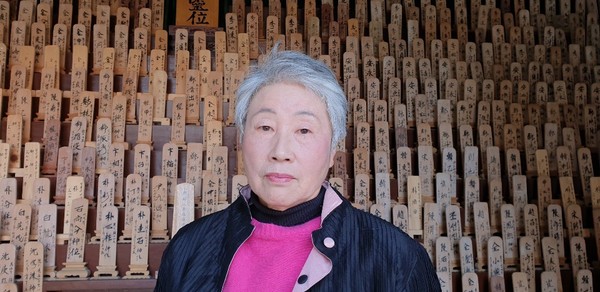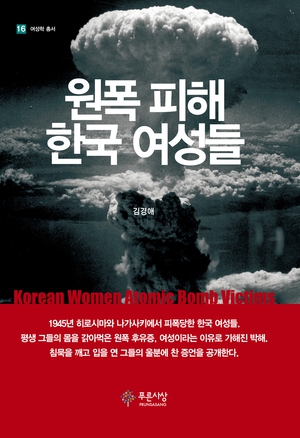 |
|
Kim Kyung-ai, former women’s studies professor at Dongduk Women’s University
|
Kim Kyung-ai’s new book focuses on oral history of Korea’s female atom bomb victims
After reaching retirement age five years ago, Dongduk Women’s University women’s studies professor Kim Kyung-ai went to live the following year in Hapcheon, South Gyeongsang Province. When she left Seoul, she gave all her books and writing accessories away to her students; she had no intention of doing any more research. She planted close to 200 different types of flowers and trees around the remodeled home where her husband had lived as a child. Seemingly poised to spend her twilight years in the bosom of nature, the scholar recently published a new book titled “Korean Women Atomic Bomb Victims” (Prunsasang Publishers).
The study was based on oral accounts of the lives of 82 Korean women victimized by the atomic bombs dropped on the Japanese cities of Hiroshima and Nagasaki. Thirty-three of them Kim met and interviewed personally between 2017 (the third year of her rural retirement) and this year; for the remainder, she turned to data from past studies. The Hankyoreh spoke to the author by telephone on Mar. 27 at her home in Hapcheon.
“After arriving here, I came to the realization that reading and writing are what I truly enjoy doing. When I was a professor, I thought I did it because I had to,” she explained.
The organization that brought Kim back into research this time was the Korean Red Cross Hapcheon Welfare Center (KRCHCWC), located in Hapcheon township around 10 minutes’ driving distance from her home. She had always passed it while traveling to Seoul or Daegu.
“In summer 2016, I read an article in the Hankyoreh’s regional section on a study they were doing on atomic bomb victims. I immediately contacted the center,” she recalled.
“I had wanted to volunteer at the center for a while. After that, I researched why the country’s only atomic bomb welfare center is in Hapcheon, and why there is a Korea Atomic Bombs Victim Association at the national level.”
As she sifted through the data, Kim became aware of the weight of suffering endured by Korean female victims of the atomic bombings.
“They were victims of not only imperialism but also of a harsh patriarchal system. No other women in world history suffered as much as these women did,” she said. “Yet there is no mention of them in Korean women’s history.”
This was the reason Kim decided to conduct interviews.
“My book is significant in being the first to address the lives of female atomic victims in Korean women’s history terms,” she explained.
What sort of suffering did the women face?
 |
|
The cover of Kim’s latest book, “Korean Women Atomic Bomb Victims”
|
“There was a woman who was carrying a child on her back, and the child was decapitated at the moment of the blast. Because of trauma from the flames when her child was exposed, she had to spend her life hidden away in an attic,” Kim said.
“They suffered terribly harsh married lives. They couldn’t have children, or the children they did have were called ‘abnormal’ and severely mistreated. They were accused of being ‘half-Japanese.’ They suffered their own physical conditions, while having to watch their own sick children failing to thrive. Nowhere else in the world is there a group that suffered such a tragedy.”
She proceeded to share some statistics. “Up until just a generation or so ago, unmarried women were treated as ‘not normal.’ They couldn’t live a real life. Yet while nearly 90% of male atomic bomb victims married, only 60% of female ones did,” she explained.
Of the 70,000 Koreans who suffered the effects of the atomic blast on Aug. 6, 1945, around 23,000 are estimated to have returned to Korea.
“There are around 2,300 survivors today. So many of the people in Hiroshima at the time were from Hapcheon that they used to say, ‘Don’t bother asking the Koreans where they’re from,’” Kim said. “A lot of them went to Hiroshima because they were struggling to survive. Of the 33 women I interviewed, 27 of them had ties to Hapcheon.”
Even today, nuclear weapons and nuclear energy remain hotly debated issues in South Korea.
“We need to understand the kinds of lives that atomic bomb victims lived and use that information as a basis for our decisions on denuclearization and nuclear policy,” Kim said.
“These were the earliest form of nuclear victims. I didn’t really know myself how terrible the damage was before I began this study. I included a lot of the victims’ accounts in the book.”
For the victims Kim interviewed, the experience of watching the Fukushima Nuclear Power Plant accident in March 2011 was especially agonizing.
“They said they couldn’t understand how something like that could have happened again. It was very hard for them,” she said. “They’ve also reacted very sensitively to North Korea’s nuclear development activities.”
When it was suggested that the magnitude of suffering might have made the interviews difficult to conduct, Kim replied, “I think I got through it because I saw it as important to leave a record.”
“The center also provided a lot of help because it was the first-ever example of a scholar doing an oral history. I think it was a healing process for the victims knowing those who truly bore the brunt of suffering in Korea’s history will be remembered. Recording history is also a healing process.”
Demands for compensation and responsibility from Japanese government
The book also focuses on the brave efforts by female atomic bomb survivors (including the late Son Gwi-dal, Eom Boon-yeon and Im Bok-soon) who spearheaded an effort to demand that the Japanese government take responsibility for damages from the atomic bombs, as well as the Japanese woman – Association of Citizens for Supporting South Korean Atomic Bomb Victims chair Junko Ichiba – who assisted them.
“Korean survivors of the atomic bomb are currently receiving about 300,000 won (US$263.89) a month along with medical coverage from the Japanese government,” Kim said, largely due to the efforts of women from both Korea and Japan.
“Currently there are about 100 people on the waiting list to be admitted to the welfare center. The survivors like being at the center. They aren’t a burden to their children, and they’re just five minutes away from a hospital. I would like our society to have the kindness to help people on the waiting list get into a government nursing home.”
Kim was one of the three students admitted into a master’s program in women’s studies that was established at Ewha Womans University in 1982, the first such university program in the country. After completing her master’s studies, she traveled overseas at the age of 40 and received a PhD in women’s studies at the University of Sussex, in the UK.
In 1976, during the dictatorship of Park Chung-hee, Kim was arrested for making handkerchiefs to raise funds to support journalists who’d been unlawfully dismissed for criticizing the military dictatorship. “I was charged with violating Emergency Order No. 9. I was locked up for about 100 days and never even put on trial,” she explained.
What academic activity has been the most satisfying to Kim as a scholar of women’s studies? “Nowadays, as I’m sure you’re aware, the Me Too movement is very active in the literary sphere. Since I was the first to underline that there were incidents of sexual violence in the literary world long ago, too, I got quoted by a lot of people in the movement,” Kim said.
Kim’s book “Cracks in the Patriarchy in Early Modern Korea,” which was published five years by the company Prun Sasang, contains three essays about Kim Myeong-sun (1896–1951), a female writer in the early modern period. “Kim Myeong-sun was a writer with a remarkable linguistic talent. She wrote song lyrics in German and translated French poet Charles Baudelaire’s collection ‘Les fleurs du mal.’ But while she was studying in Tokyo, she was sexually assaulted by Lee Eung-jun, who would go on to become the first chief of staff of the Korean army. Even after that, she faced secondary victimization from other literary figures of the time such as Kim Dong-in. Despite that, even female contemporary literary critics have disparaged Kim Myeong-sun as having been sexually promiscuous and obsessed with a string of romantic conquests.”
More than 37 years have passed since Kim Gyeong-ae embarked on the path of women’s studies, which prompts the question of how gender equality in Korean society has changed in the intervening years.
“A lot has changed. The biggest change is that women have learned how to speak up. Women understand precisely the reality that they face today. In the past, we had to explain to women that they were being oppressed or discriminated against. Women have learned how to view their situation objectively and how to talk about it,” Kim said.
Kim’s view on misogyny among younger generations
How should we regard the misogyny that is being expressed by some segments of the younger generation? “Koreans in their 20s seem to be having a hard time and experiencing a lot of uncertainty these days. They’re projecting such feelings in the language of hatred toward an even weaker group. I wish they would focus on togetherness instead of hatred and confrontation. Women also need to think about sharing not just men’s rights, but their responsibilities as well.”
What about Kim’s plans? “Since I live in the countryside, I get to hear stories about ordinary women in rural communities. I want to record the stories of rural women who have endured poverty and other challenges while Korean society has been undergoing dynamic changes. We know what married life was like for our mothers and grandmothers, but no one has written it down. In the future, I plan to take my time doing exactly that.”
By Kang Sung-man, senior staff writer
Please direct comments or questions to [english@hani.co.kr]










